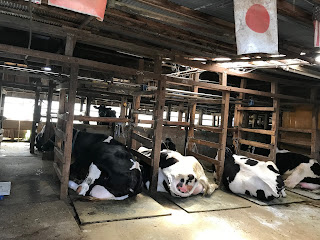Spring is the perfect time for an afternoon bike ride. The weather isn't too hot, instead it is sunny and invigorating. There are discoveries left and right of all sorts. Add the feelings of health for just getting on the bike and it adds up to a fun day.
Everything was going great, until we reached the dairy. We purchased the ice cream made with the dairy's milk from a little office across the street from a couple sheds. I could smell the cows (not offensively, but if you've driven through the country, it's a very distinct smell), but I couldn't see them. There were houses all around and no fields within sight. I asked my husband about the cows and he led our son and me over to the sheds. Behind a wall of blue tarps, I peeked in to see rows of cows standing and laying down in stalls. They were tied to their "station" with only a few steps of space in any direction. It was obvious that the floor had recently been cleaned because there wasn't any feces behind the cows, yet I wondered where they roamed. After asking my husband, he then went up the chain of information and asked the farm hand that was tending the cows. The farm hand (he wasn't the owner) said the cows didn't get outside time anymore due to complaints from the neighbors.
I honestly didn't realize as I set out on my trek that I had a lot of preconceived notations about what a dairy farm should look like. I've been to many farms in the US and have always bought into the concept that animals put out in healthy green pastures (be it cows, sheep, goats, chickens, and so forth) are healthier and happier animals. My belief extends to the idea that healthy and happy animals make higher quality food. In the US, I bought my pork and beef from a wonderful farm in Tenino that I visited on more than one occasion. The farming practices on that farm were amazing, leading to very happy animals. I raised some of my own chickens (some for eggs and some for meat) and was very picky about where I would buy them from. Basically, I knew (or tried my best) to know where a lot of my food was coming from.
It took me years to gain the knowledge I had in the US and even longer to do something about my participation in the food chain. When I first moved here, I looked for organic food and tried to buy as much of it as I could find and afford (organic food is absurdly expensive here). But this effort only went so far because I was overwhelmed with the transition. I simply cannot maintain the food standards I established in the US while I am in Japan because I am new to their system. I am starting back at square one by just starting to learn about Japanese food practices. Frankly, I am shocked by the things I am learning about the standards for what is okay here. I am having to come to grips with the truth about lack of space and what that means for growing food for the millions of people in this country. To me, this truth isn't pretty and I'm upset about it. Adding onto the mixed feelings, I'm also struggling with trying to grasp whether I am judging the farming practices based on what I believe to be basic animal treatment standards or is it an elite American perspective.
When I saw those cows and how they were living, I was sad. I was sad for the cows and for the life I thought they should be living. I was also confused about my participation in their treatment. By purchasing the ice cream that their milk made, I was supporting how they were being treated. That realization didn't not sit well. Even though they were living in pretty clean stalls and were fed 2 meals (grain) and 3 snacks (hay) everyday, they were still living in a cage. What compromises am I willing to make based on cultural differences? Am I going to be able to knowingly participate in a food chain that makes me uneasy?
My head hurts. I can't figure this out in a day. I need to figure out a way to research more with my limited language capabilities. I don't think I have a complete picture of what the food chain really looks like here, but what I have seen has left me struggling on so many levels.







I struggle just here, with knowing the language, and the resources, and the choices available. I can't imagine trying to navigate these choices in another language.
ReplyDeleteMy husband grew up in a dairy town--Tillamook, Oregon. That has definitely colored his perception of cows--but we are lucky to be able to make choices, like free-range, organic, grass fed. And lucky to be able to afford them.
<3
Delete